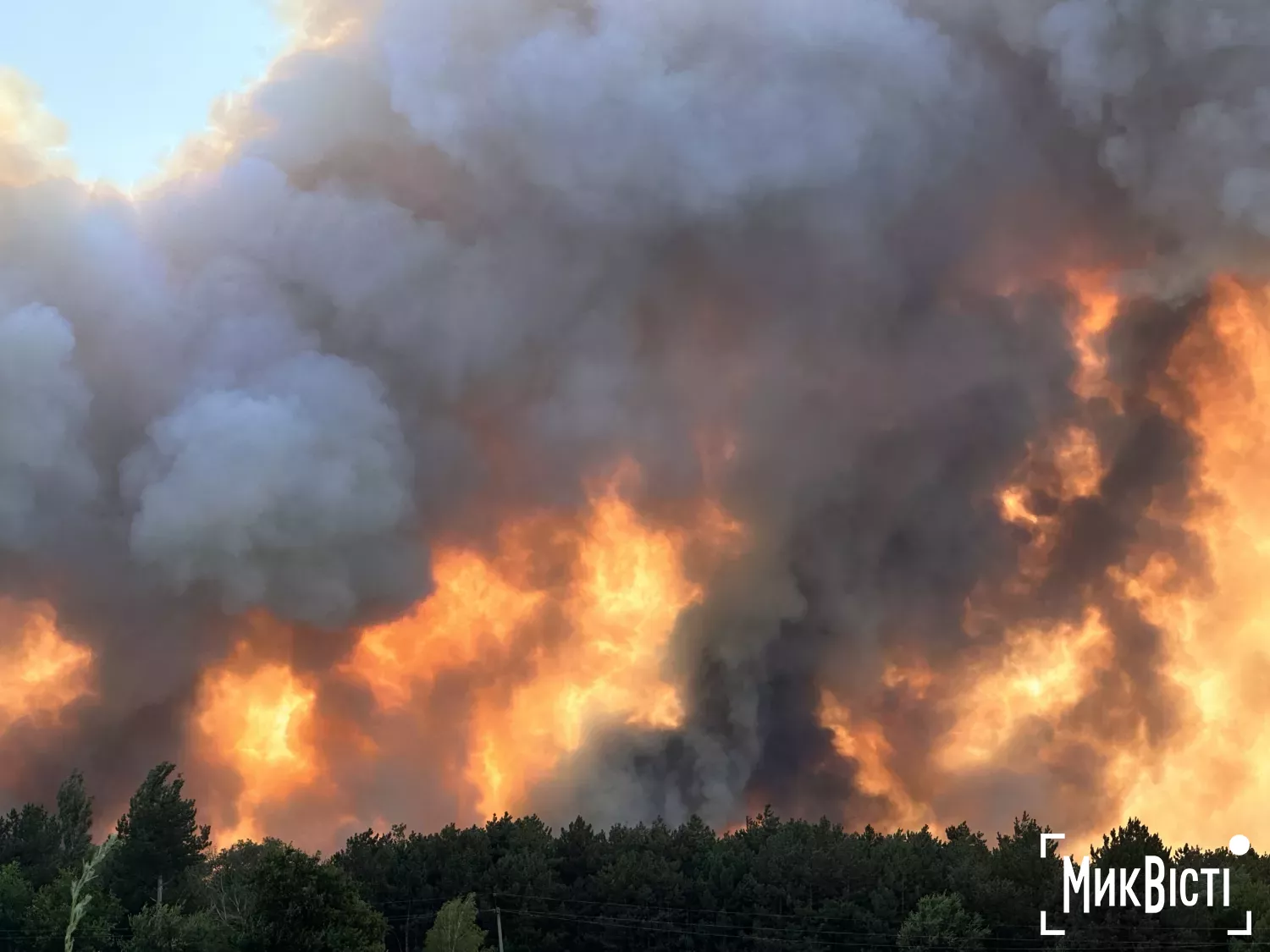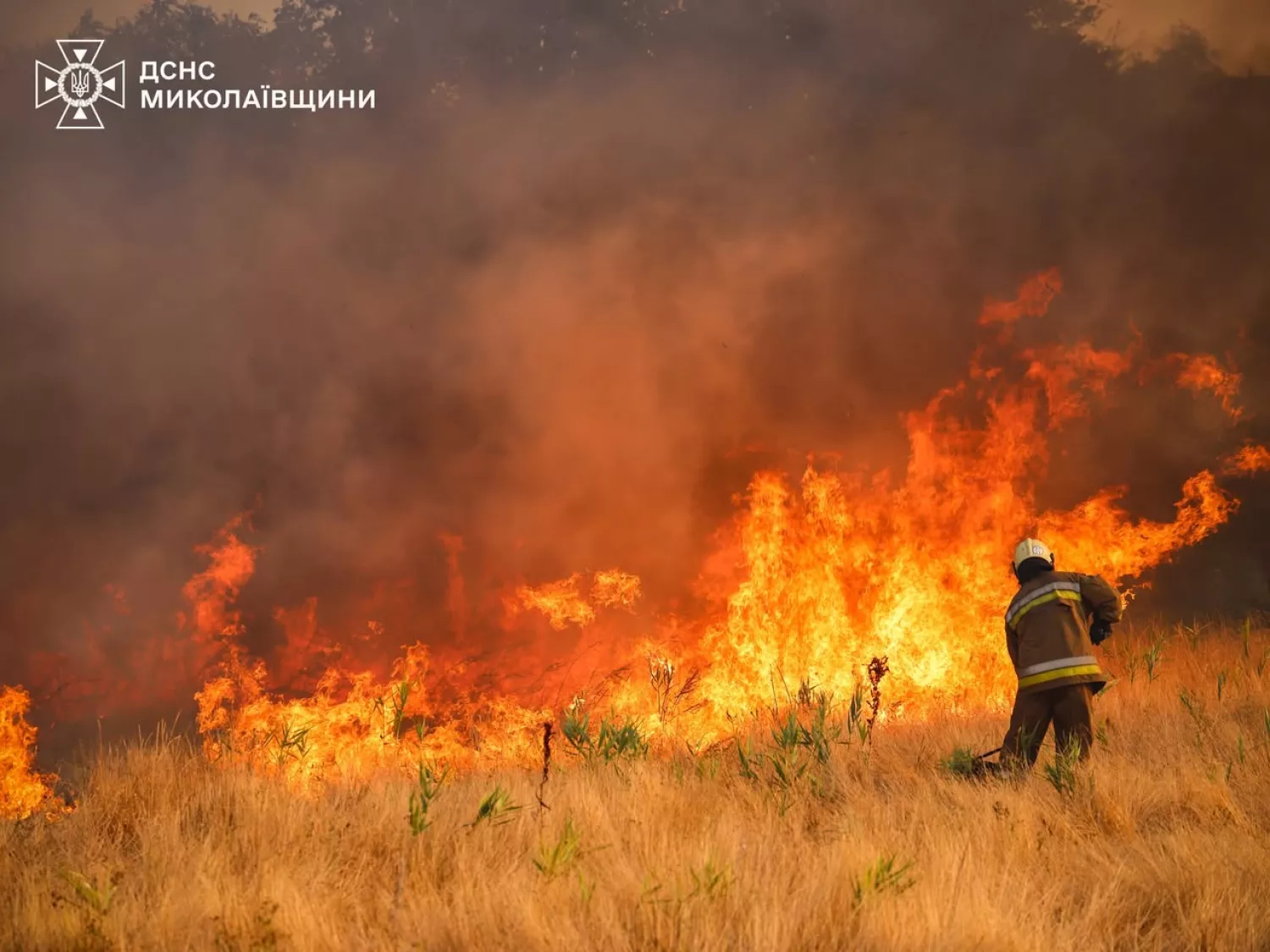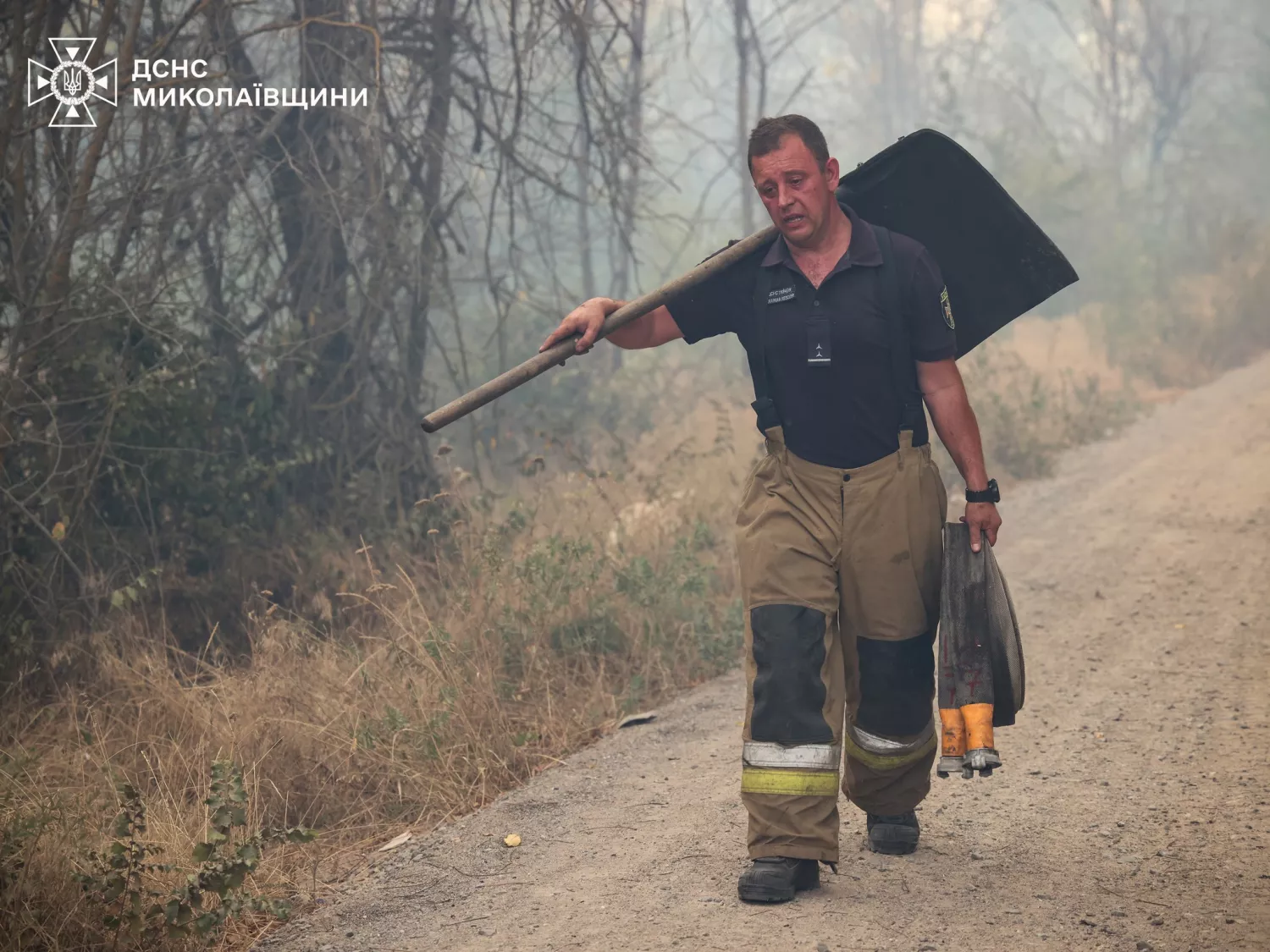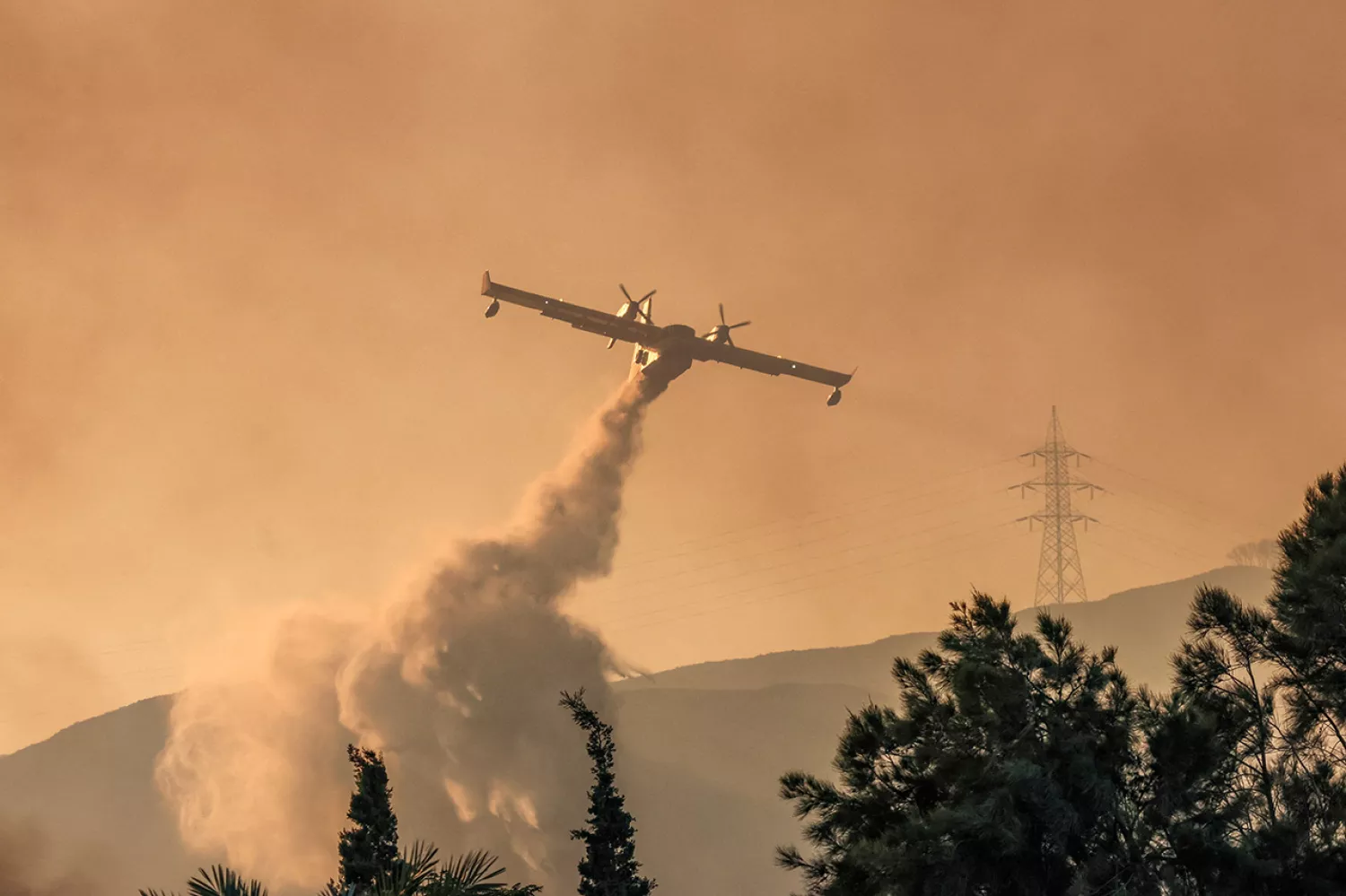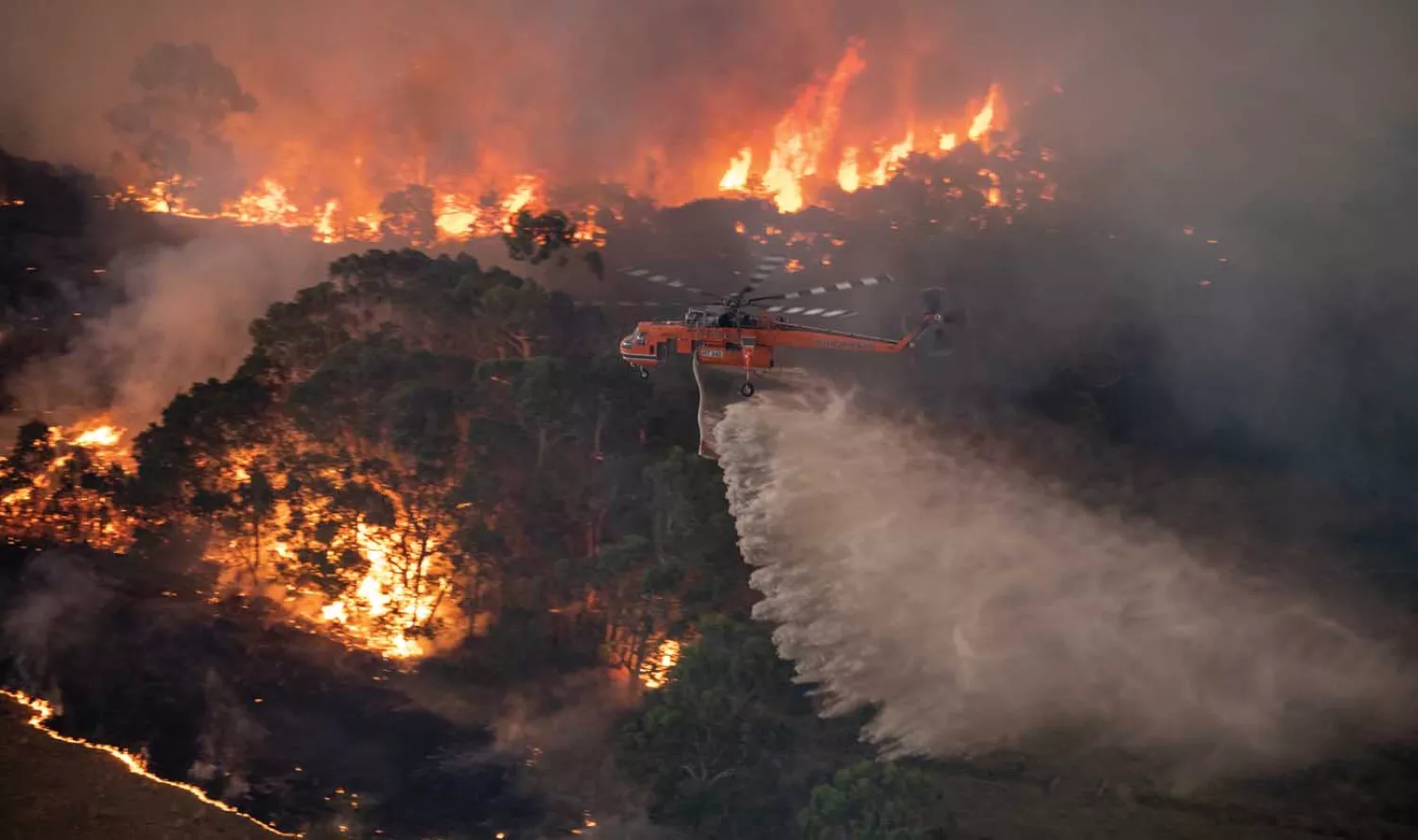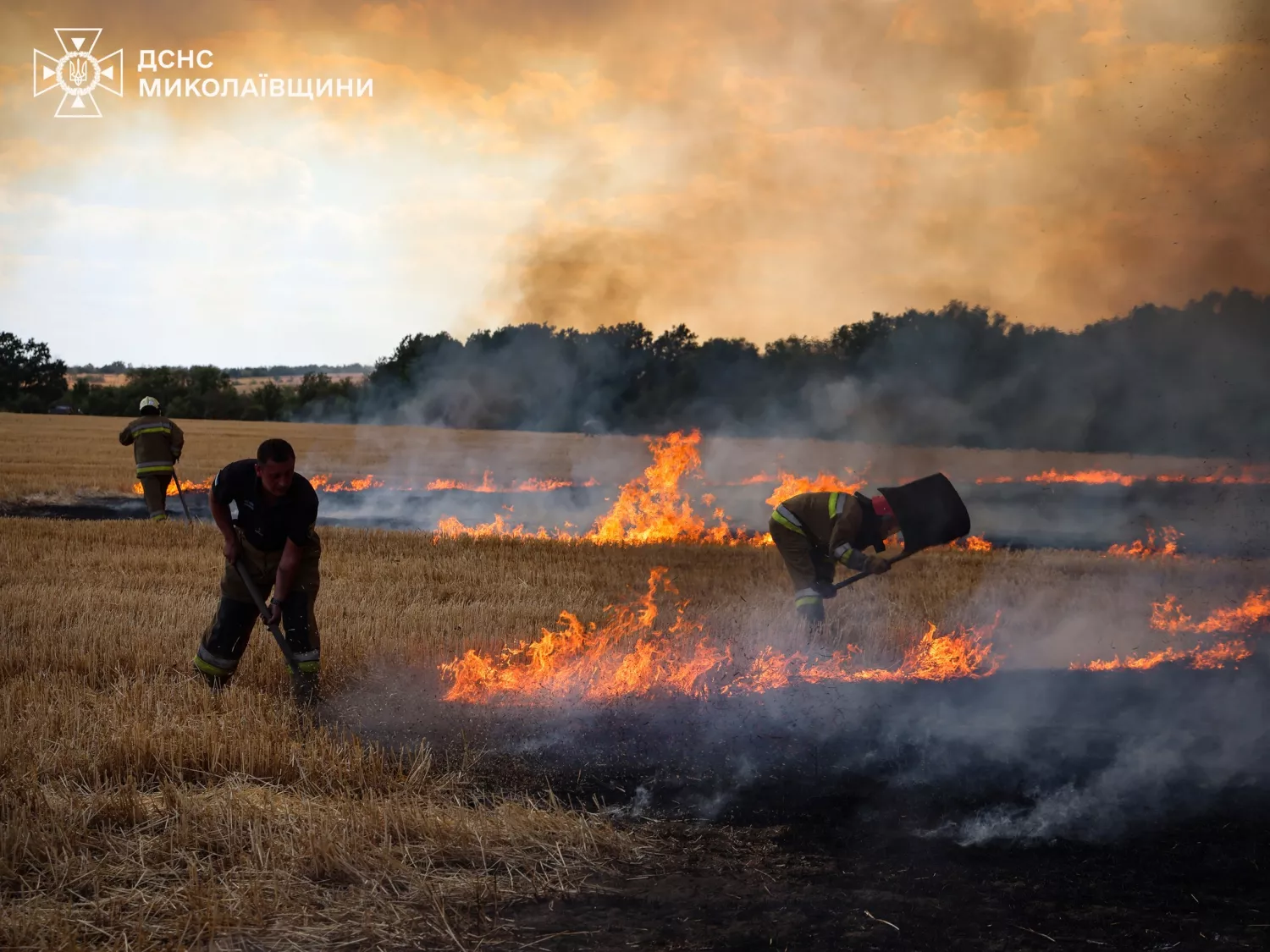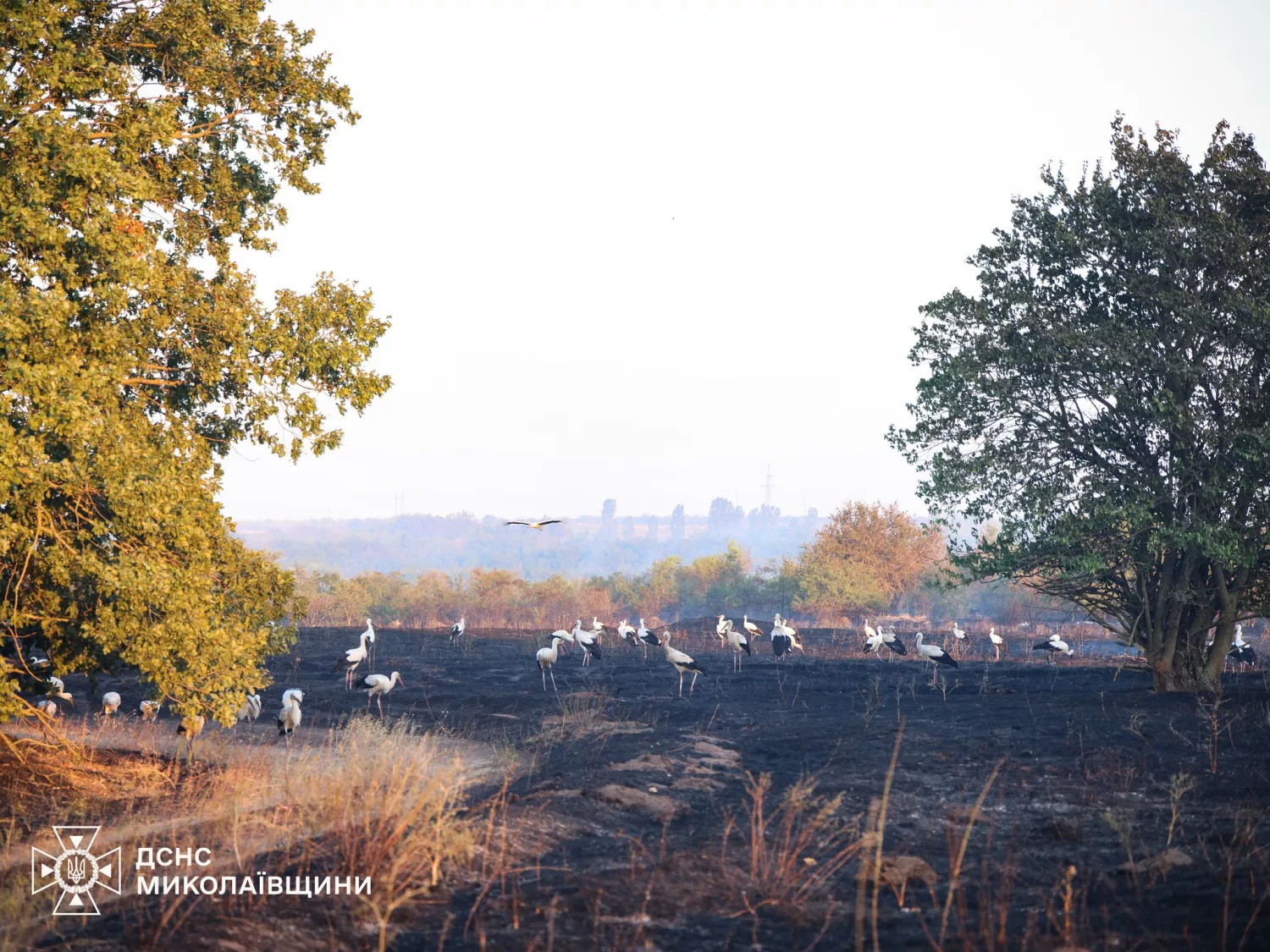«There’s hardly any forest left». Why is Mykolaiv region engulfed in fires and how does this affect the environment?
- Yuliia Boichenko
-
•
-
17:03, 19 August, 2025
Since the beginning of the year, more than three thousand fires have occurred in the Mykolaiv region. The reasons are various: shelling, human negligence, arson. But this number has only begun to grow rapidly in the last few weeks: the situation has been exacerbated by the heat and lack of rain. Now fields, forests and dry grass are burning every day in the region. The wind spreads the fire quite quickly, and as a result, the flames reach residential buildings.
Rescuers respond to calls every day, sometimes several times a day. Some fires have to be extinguished for several days in a row. All this is done together with local businesses and residents, as the SES units alone are not able to deal with such a large number of fires.
After the fire, the site is left with scorched earth, burnt trunks of perennial trees and the smell of smoke. NikVesti decided to find out how local residents live in the face of constant fires and how this situation affects the ecology of the Mykolaiv region.
«We put out fires with shovels and cloth». How do residents help the SES extinguish fires?
For two weeks in a row, the Variushynskyi forest and nearby villages have been on fire in the region, said local resident Tatiana Kretovych, who helped put out the fires.
«We've had fires before, but this is the first time we've had such a large-scale fire. Firefighters and foresters are working quickly. But the fact is that we burn when the wind is blowing. Right now, the same forest that we extinguished last week has caught fire again. Back then, we had 150 rescuers and 31 pieces of equipment. It was impossible, just a nightmare», the woman said.
Due to wind gusts, the fire reaches residential buildings. Thus, two houses have already burned down near Variushyne, a local resident said. According to her, a young couple with children lived in one of them. They were in the house at the time of the fire, but fortunately were not injured.
«In Novyi Horodok, near Variushyne, fields were burning and people's houses even burned down. A family with two children lost their house. It is impossible to live there. Their roof burned down instantly, the ceiling collapsed. The family was in the house at the time. The boy ran to put out the fire, and the girl just managed to grab the children out of the house. They are fine now. But now it's easier to build a new house than to restore the old one», said Tatiana Kretovych.
People are trying to help the rescuers put out the fires: they do it with shovels, firecrackers and wet cloths.
«We help. But, you know, when there is a surface fire, of course, people without special skills cannot do anything. The State Emergency Service is helping us a lot,» said Tatyana Kretovich.
Local businesses, farmers and landowners are also involved in extinguishing the fire by providing water tanks.
There is now a burned-out area of the Variushynskyi forest, the woman says.
«It's a nightmare there. I'll tell you that there is no forest anymore. There is still a little bit of mixed stuff left.
That's how it started on 28 July and hasn't stopped. Firefighters are on duty all the time because it catches fire again and again. Yesterday it was just quiet, the weather was calm, nothing was burning or smoking anywhere. And today it started again», the woman said worriedly.
In addition, fields, forest plantations and vineyards burned down near Variushyne, the local resident added.
«These are the vineyards of an unshared state-owned enterprise «Vynohradna Valley». But they have not been cultivated for several years. That is, the fields caught fire, the vineyards caught fire, and so it went to the houses, to the gardens. Forest plantations, where the road is on the side of the road — everything burned down.
If the smoke had blown into our village, I can tell you that the village would have burned down, too. Because here the forest is very close to the gardens — about 100 metres away», added Tetiana Kretovych.
«We need reinforcement». The SES units alone are not enough to deal with this volume of fires
In total, since the beginning of 2025, 3,195 fires have occurred in Mykolaiv region, 70% of which (2,206 fires) were in open areas, the Main Department of the State Emergency Service in Mykolaiv region told NikVesti.
Often, in the SES reports, you can see that shrubs, reeds, stubble, and dead wood were burning. So let's look at the differences between these concepts in order to better understand the fire situation in the region.
- Reeds usually grow on the banks of water bodies, in swamps and marshes. It is a moisture-loving perennial plant.
- Stubble is the remains of grain stalks on the field after harvesting.
- Shrubs are woody perennial plants with several trunks (e.g. blackthorn, dog rose).
- And dead wood is a general term. It is used for dry vegetation that poses a fire hazard: grass, branches, weeds.
The SES says that since the beginning of the year, there have been 6 fire-related emergencies in the region, mostly in forests and fields. This includes a fire in the Variushynskyi forest, where 45 hectares have already burned down.
«A fire starts when three conditions are present simultaneously, creating the so-called fire triangle: a combustible substance, a heat source and oxygen. And in the presence of wind, firefighting becomes more difficult. However, in most cases, fires are caused by the human factor.
The main cause of fires in natural ecosystems in our region is mainly carelessness with fire or carelessness while smoking. This is 821 fires out of the total number. Therefore, the main thing is responsibility, awareness and compliance with fire safety rules», the SES explained.
They clarified that in some cases of fires in the region «there is a need for additional staffing».
«During peak periods, the workload on personnel increases significantly, especially during the fire-hazardous period. Despite the difficult situation, the units acted on their own without assistance from other regions», the SES says.
Global experience: how do rescuers reinforce each other in large-scale fires?
There is a practice in the world when rescuers from other regions are involved in extinguishing large-scale fires in one region. Such situations have occurred in Greece, Australia, and the United States in recent years. The scale of the fires there was, of course, larger than the ones that are currently occurring in Mykolaiv region. However, this approach still shows how quickly it is possible to distribute forces, localise the most dangerous foci and prevent the fire from spreading to residential areas.
One example is the Greek island of Rhodes, where fires broke out in the summer of 2023. Due to the abnormal heat and strong winds, the flames spread further across the island, and their height sometimes reached 5 metres, Reuters reported at the time. As a result, many hotels closed their doors and about 19,000 tourists were evacuated.
Tens of thousands of hectares of forest, villages and tourist areas were on fire. There were very few local firefighters at the time: fires were burning in several places at once, and the situation was getting out of control. The government set up a system of mutual assistance between regions: fire brigades from mainland cities, as well as rescuers from Cyprus, Romania, France and Poland, arrived in the affected areas. They weren't just airlifted in — each group included specialists in forest firefighting, engineers with drones for monitoring, and medics.
Another example is «Black Summer» in Australia. After years of drought, the Australian bushland became extremely dry, and the country faced one of its worst bushfire seasons from September 2019 to March 2020, killing 34 people and burning 3,000 homes. About 3 billion animals have been killed or displaced by the fires, according to a report by the World Wildlife Fund (WWF).
The fires destroyed more than 11 million hectares of land in southeastern Australia, which is about half the territory of the United Kingdom.
Hundreds of rescuers from other states — Victoria, South Australia, Queensland — as well as from abroad, including Canada, the United States, New Zealand and even the US Department of the Interior, were sent to help. Their mobility made it possible to quickly reinforce units on the burning fronts, to give a brief respite to local volunteers and rescuers — who have been fighting day and night to save lives and nature
«There is a choking smell of smoke». Houses and farms are burning in Kutsurub because of enemy shelling
The situation with fires in the Mykolaiv region is also complicated by hostile shelling. Since the beginning of 2025 alone, 120 fires have occurred in the region: fields with grain, crop residues, houses, etc. have burned. If we look at the statistics by district, it looks like this:
- Pervomaisk and Voznesensk districts — 3 cases each;
- Bashtanka district — 10;
- Mykolaiv district — 104.
The frontline communities of Ochakiv and Kutsurub, as well as the occupied Kinburn Spit, suffer the most from shelling.
One of the latest fires caused by hostile shelling occurred this month — on the night of 12 August in the village of Kutsurub community. As a result of the shelling, a building on the territory of a farm and dead wood burned. In total, the burning area reached more than 2 hectares, and the fire was extinguished by rescuers.
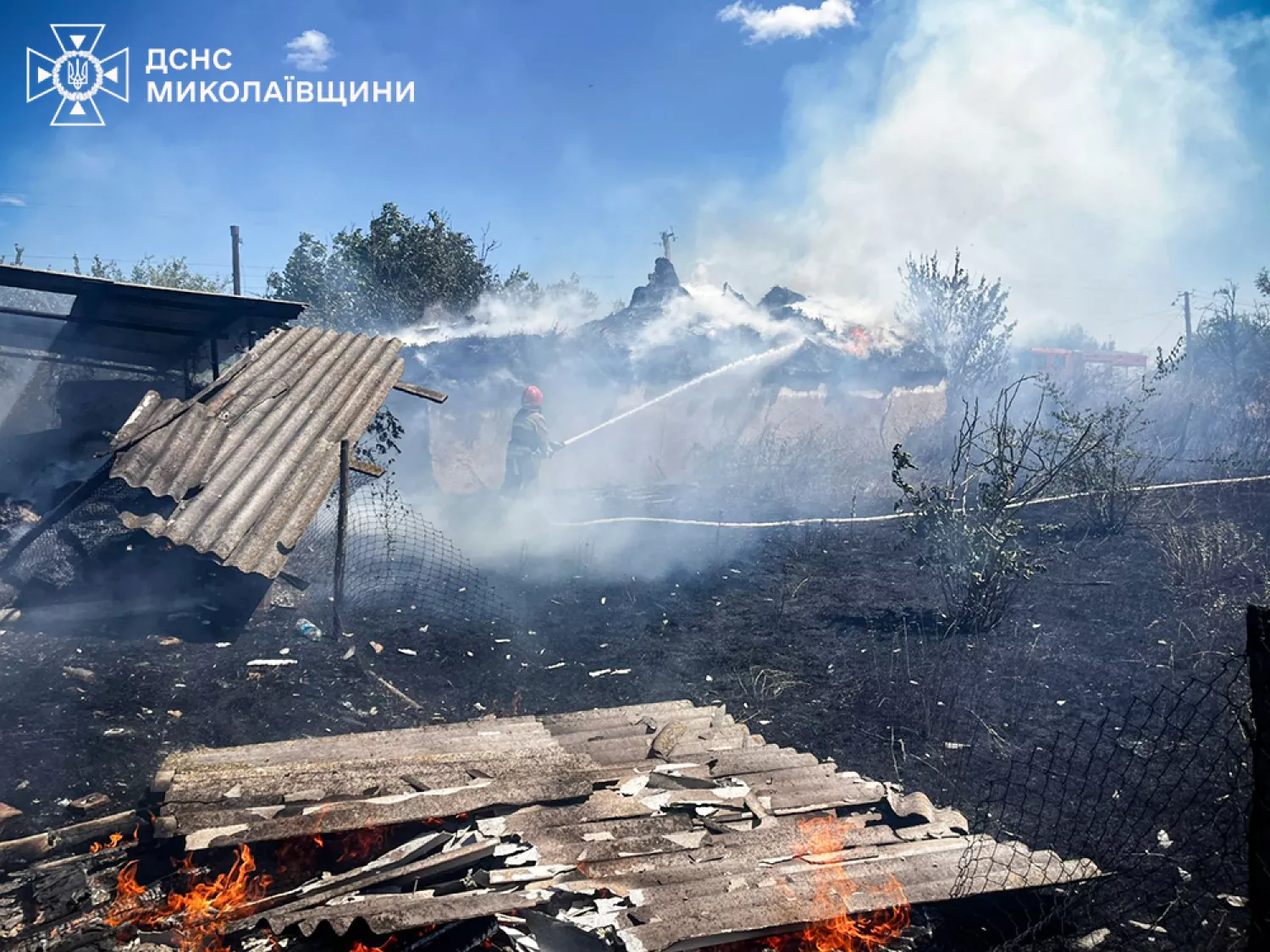 A house in a community in Mykolaiv region burned down during a fire caused by shelling, 12 August 2025: SES
A house in a community in Mykolaiv region burned down during a fire caused by shelling, 12 August 2025: SESBefore the rescuers arrive, residents usually try to put out fires on their own, as the fire quickly spreads to a larger area due to drought and wind, said local resident Iryna.
«In our community, shelling happens almost every day. This causes fires. Forest belts and fields are particularly affected — everything there is very dry. In some villages, houses and residents themselves are seriously affected by the shellings — the FPV drones are literally chasing people. If a fire breaks out, we try to put it out on our own: neighbours and residents help as much as they can. It is difficult for fire trucks to reach us because of the poor road conditions, and the fire often spreads very quickly.
After the fires, there is a choking smell that lingers for a long time even after they are extinguished. The constant shelling still has a strong impact on our morale: people are tired of the war, their nerves are giving out, but we are holding on and trying to support and help each other», the girl said.
Fires caused by shelling also occur in Mykolaiv. One of the most recent was on 2 August. Residential buildings and vegetation burned as a result of the shelling of the city. This was witnessed by a journalist of NikVesti Mariia Khamitsevych. At the time, she was in her own apartment, near where the fire started.
«My family and I were having a rest, the child was getting ready for bed. Suddenly, a bright blaze appeared outside the window. We didn't even realise what was happening at first. The next moment, there was an explosion, and my windows were shattered . The child was very frightened.
When we had recovered a little, we saw a fire outside the window, not far from the private houses. The smoke made it hard to see what was burning. We heard neighbours screaming: someone was calming the children, someone was finding out if there were any victims», she recalls.
The fire of dry grass in front of the house was extinguished quite quickly, the journalist said. The fire in the private sector took more than 4 hours to extinguish.
«People began to extinguish the flames with their own hands — with tree branches. On the other hand, firefighters were working closer to the private houses. The fire near our house was extinguished in about 15 minutes, but in the private sector, the flames continued to grow. We could hear the sounds of sirens. We went to bed around two in the morning, the fire was still being extinguished, although it was not as large. But now there's only scorched earth there», said Mariia Khamitsevych.
«Almost everything is dying». How do fires affect the environment in Mykolaiv region?
The State Ecological Inspectorate of the South-Western Region has calculated the damage that fires have caused to the environment of Mykolaiv region during the «fire-hazardous period» since April 2025 to be 1.36 billion hryvnias.
Such damage, for example, to forests, is calculated by the number of trees destroyed, an ecologist and head of the Mykolaiv branch of the National Ecological Centre of Ukraine told NikVesti. At the same time, he added, it is impossible to calculate the number of destroyed plants and dead animals, as the fire turns the area into a scorched earth.
«For example, we had forests burning in Variushyne and in the Andriivka reserve tract. They mainly count the damage, how many trees were burnt. There are dachshunds there, so you can count. But, of course, no one can count the number of insects, pheasants, birds, or plants, including those in the Red Book, that were burned. It is very difficult to calculate all this when instead of a protected tract, we got a burnt-out field», says Oleh Derkach.
The ecologist says that «we underestimate this damage», because it is not limited to environmental damage.
«For example, the destruction of vegetation is one harm. But after that, we provoke soil erosion, thus destroying it. This is a multidimensional damage: soil destruction, soil erosion, destruction of vegetation, fauna, air pollution and much more. The damage from fires is enormous», the ecologist explained.
At the same time, the number of fires is only growing every year, says Oleh Derkach. This is primarily due to climate change, he added.
«When I worked as the head of the «Tilihulskyi» park, the number of fires increased every year. This was primarily due to hot summers. That is, say, until about 10 June, the grass stays green, then it turns straw-coloured, dries up, and somewhere in July and August we have a fire safety emergency», he explained.
However, the ecologist says, such weather conditions are more likely to increase the scale of fires, because the causes of their occurrence are different: enemy shelling and human influence.
«Why do such fires occur in natural ecosystems? In most cases, fires are caused by the deliberate burning of dry vegetation. That is, people set fire to pastures, stubble, and post-harvest residues, and then cannot control this process. The wind picks up the fire and spreads it. We are also now in martial law — under constant shelling», explained Oleh Derkach.
Fires lead to the loss of biodiversity, say experts from the World Wide Fund for Nature Ukraine. The massive death of flora and fauna can disrupt food chains, which causes long-term changes in the structure of the entire ecosystem. Such changes lead to the extinction of sensitive plant and animal species and the emergence of invasive species.
Fires also cause significant changes in aquatic ecosystems. In particular, this concerns the deterioration of water quality. Ash, the burnt remains of plants and animals, get into water bodies. This can increase the concentration of various chemical compounds in water, including heavy metals (such as lead and mercury), nitrogen, and phosphorus.
Significant emissions of carbon dioxide (CO₂) from fires increase the greenhouse effect, which contributes to climate change.
That is, a fire is not only «about burnt trees», but also the death of animals and plants, loss of biodiversity, changes in the microclimate, deterioration of soil and water quality, and years to restore ecosystems.
Negative impact on public health:
-
Combustion products contain harmful chemical compounds that can be carcinogenic and enter the human body through drinking water in wells or food grown in contaminated areas. Even after the immediate effects of the fires are overcome, long-term health problems may arise: exacerbation of chronic diseases, impaired immune system functions, etc.
-
Deterioration of air quality. Fires release combustion products, including soot and fine particles, into the air. This can cause respiratory diseases, allergies, and worsen overall health (which is especially dangerous for people with chronic lung and cardiovascular diseases).
Shelling in Mykolaiv region is causing an increasing number of fires, especially in frontline communities. However, many fires are also caused by human negligence — burning dry grass and stubble. The situation is now being exacerbated by heat and strong winds, which quickly spread the flames, turning localised fires into large-scale blazes. The consequences are scorched land, destroyed perennial trees, deaths of animals and birds, and a threat to human life and property. Everyone's responsibility and compliance with fire safety rules is the key to preserving nature and safety in Mykolaiv region.
Yuliia Boichenko, NikVesti
